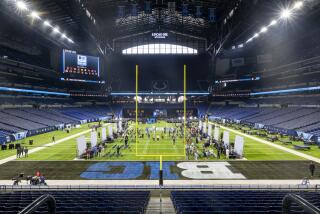Pro sports leagues aim to put workers’ comp out of play
- Share via
One would think that we’ve learned from bitter experience not to trust a word uttered by our major professional sports leagues.
Yet here they are trying to put another howler over on us. This is their assertion that retired pro athletes — many of them from outside the state — are ripping off California’s workers’ compensation system for hundreds of millions of dollars.
The state Legislature is setting itself up to swallow this one whole: A bill to close this supposed loophole has been introduced by Assembly Insurance Committee Chairman Henry Perea (D-Fresno).
Let’s start with the bottom line: This bill would be a total sellout to the major pro sports leagues and their billionaire team owners, who pay the workers’ compensation claims won by their workers. Its victims would be athletes whose limbs, joints, backs and craniums were pounded relentlessly on the field of play and who were left with inadequate treatment or support after they retired.
Let’s also home in on whose interests are most at stake: It’s the National Football League, which is facing a tidal wave of legal claims related to long-term neurological damage suffered by players. Claims from more than 4,000 players and their families have been consolidated in a single immense lawsuit in Philadelphia federal court, where pretrial maneuvering has been lumbering on for months.
Among their allegations is that the NFL suppressed evidence that the concussions caused by its style of play could have long-term health consequences. The league has consistently denied that it tried to mislead players.
Perea’s bill serves the NFL and the pro sports leagues and teams in basball, basketball, hockey and soccer. (Apparently lacrosse, rugby and softball leagues didn’t have the juice to get their way in Sacramento.) It’s purportedly a response to the upsurge in workers’ comp claims filed by pro athletes, including many who never played for California teams, that started around 2007.
There were several reasons for the increase. Under state law, you can file a claim if you can argue that you suffered an injury in California, even if your employer was located elsewhere; it’s a rare pro athlete who doesn’t occasionally play an away game against a California team.
More important, California is one of nine states that allow workers’ compensation for “cumulative trauma” injuries, those that build up over time. The most familiar of these are carpal tunnel injuries suffered by typists. But they also encompass knee or back damage from years of blocking and tackling, or neurological damage from repeated concussions.
“The NFL is not terribly worried about cumulative knee trauma,” says Frank Neuhauser, a social insurance expert at UC Berkeley. “They understand what they’re going to pay for that. But they’re terrified of brain injuries, which can cost millions and result in complete disability.” The NFL didn’t reply to my request for comment on the workers’ comp issue.
It’s hardly shocking that the NFL and other major leagues would want to shut down this avenue of compensation. Nor is it very surprising that they would resort to disinformation.
“The NFL knows this could be detrimental to their bottom line,” says attorney Mel Owens, who played nine years for the Los Angeles Rams in the 1980s and now represents athletes in workers’ comp cases. “So they couch it in terms of players abusing the system.”
The leagues’ bid for sympathy depends on most laypersons having no idea about how workers’ compensation works. So here’s a primer. To begin with, taxpayers don’t pay for workers’ comp; employers do, either by buying commercial workers’ comp insurance or (if they’re big enough) self-insuring. Their premiums are overwhelmingly based on their type of business and their claims record. The premium paid by the employer of file clerks will be very different from that of a skyscraper builder.
Therefore, if California workers’-comp judges take a more liberal view of long-term brain injuries for football players (and as yet there’s no evidence that they do), that may drive up premiums paid by sports teams, but it won’t affect the premium paid by grocery stores.
The leagues “are trying to make it look like these are costs that will fall on all employers,” Neuhauser says. “But it has nothing to do with current rates. Sports teams’ premiums will go up, but not those for construction companies or anyone else.”
Then there’s the notion, also happily peddled by the leagues, that the athletes are getting away like bandits, abetted by aggressive lawyers. A 2012 analysis done for the NFL and the professional baseball, basketball and hockey major leagues by the benefits consulting firm Milliman Inc. estimated the cost of already-filed California cumulative trauma claims by athletes at $747 million.
That sounds like a lot, until you realize that it covers 4,500 players, for an average of $166,000 each, which includes the cost of medical treatment. Is that a lot for injuries that may be crippling for life and include Alzheimer’s or other neurological syndromes? For a player judged partially but permanently disabled, the maximum benefit is $270 a week for up to 320 weeks. Long story short: No player is getting rich off these payments.
Nor are the players typically coasting into retirement with superstar nest eggs. Consider Reggie Williams. A standout linebacker who played 14 seasons for the Cincinnati Bengals, including two Super Bowls, he made $45,000 in his rookie year, 1976, and topped out at $445,000 after 14 seasons.
Now 58, Williams has suffered through 24 operations on his right knee, leaving the knee looking like hamburger and that leg 3 inches shorter than his left. “I never played a game where I didn’t get hurt,” he told me. That includes 14 games in California against the Rams, Raiders, 49ers and Chargers. “Now I wake up every day in extreme pain.” Five years ago he had to leave a job with Walt Disney Co. because he could barely stand on his feet.
In 2008, Williams filed for workers’ compensation in California, but the Bengals have blocked that claim, for now, arguing that under his employment contract he was required to file in Ohio. If the team wins, he may be out of luck, for the statute of limitations on Ohio workers’ comp claims has long passed, and the state doesn’t cover cumulative trauma.
“The NFL doesn’t want to be liable for any of this,” says Williams’ lawyer, Owens. He points out that taxpayers bear the ultimate cost if the leagues skate on their obligations. “If the players can’t get workers’ comp benefits and they can’t get health insurance, they end up on Social Security disability and Medicare,” Owens said.
Why California legislators should bend over backward to help out franchise-owning plutocrats is a mystery. That’s especially true since the reason athletes have to resort to workers’ comp in the first place is that the owners have abdicated their responsibility to care for the injured players who have made them rich. Sure, they’ll pay lip service to player health, but talk is cheap. It looks even cheaper in light of the NFL’s new broadcast contracts, which are worth more than $40 billion over the next decade.
If the leagues want their California problem to go away, that would be easy: reach deals with the players’ unions providing lifetime injury coverage superior to what they can get from workers’ compensation. That’s a very low bar, even when you’re trying to clear it while carrying bagfuls of money.
Michael Hiltzik’s column appears Sundays and Wednesdays. Reach him at [email protected], read past columns at latimes.com/hiltzik, check out facebook.com/hiltzik and follow @latimeshiltzik on Twitter.
More to Read
Inside the business of entertainment
The Wide Shot brings you news, analysis and insights on everything from streaming wars to production — and what it all means for the future.
You may occasionally receive promotional content from the Los Angeles Times.











